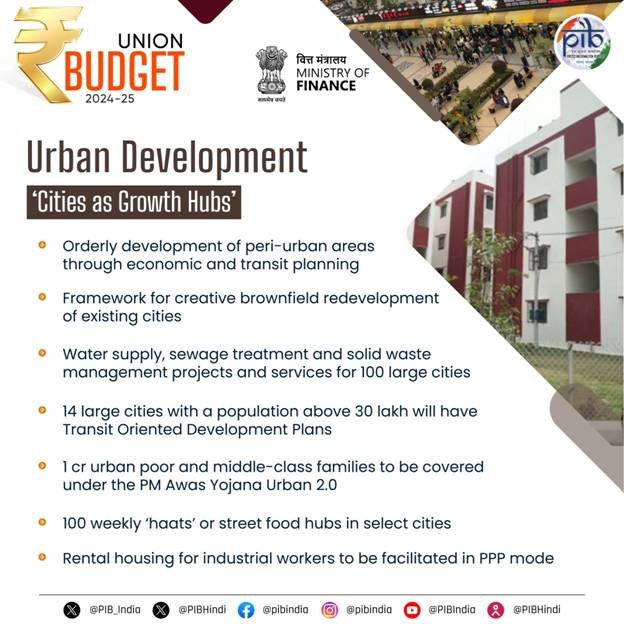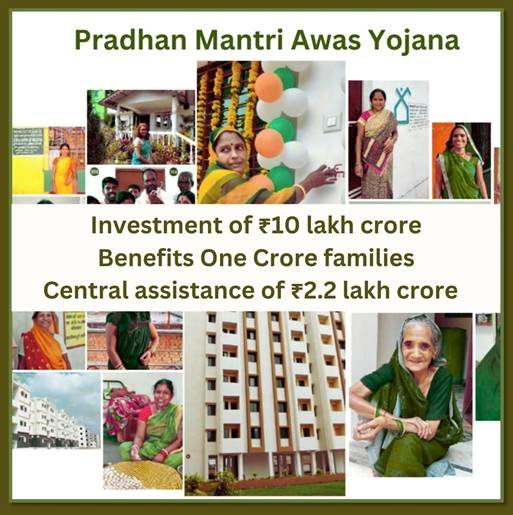
India a country of about 2 million homeless and about 100 million urban slum dwellers, access to adequate housing has been a longstanding challenge, particularly for economically weaker sections of the country. Recognizing this crucial need, the Government of India launched the Pradhan Mantri Awaas Yojana (PMAY) in 2015 and government has taken it one step further by announcing Urban Development by PM Awas Yojna in Budget 24.
Since its inception in 2015 for urban areas and 2016 for rural areas, the PMAY has focused on providing pucca houses with essential amenities such as household toilets, LPG connections, electricity, and functional household tap connections. The scheme also mandates that the female head of the family be the owner or co-owner of the house, promoting women’s empowerment among economically weaker sections (EWS) and low-income groups (LIG).
Pradhan Mantri Awas Yojana has been the largest affordable housing initiative globally with the ambitious goal of providing “Housing for All” by 2022 (but earlier on 8th December 2021, Union Cabinet decided to extend the Pradhan Mantri Awas Yojana- Gramin for three more years till March 2024) to economically weaker sections (EWS), low-income groups (LIG), and even middle-income groups (MIG).
Read about Prime Minister’s Package for Indian Youth in Budget 2024
Table of Contents
Provision under Budget 24 for Urban Development

Out of 9 priority sectors mentioned in the budget, Priority 5 focuses on Urban Development under which the government has announced many schemes and initiatives.
The Union government’s key focal point was Urban Development by PM Awas Yojna in Budget 24 which is addressed through various initiatives aimed at improving housing, rental facilities, city planning, water supply, sanitation, and support for street vendors to urban and rural populations.
Expansion and Investment for PM Awas Yojana
For Urban Development by PM Awas Yojna in Budget 24 government has announced the allocation for the construction of three crore additional houses under the PM Awas Yojana, covering both rural and urban areas.
This includes PM Awas Yojana Urban 2.0, which aims to address the housing needs of one crore urban poor and middle-class families with an investment of ₹10 lakh crore. Central assistance of ₹2.2 lakh Crore will be provided over the next five years to support this initiative. Additionally, the scheme will offer interest subsidies to facilitate loans at affordable.
Rental Housing
For Urban Development by PM Awas Yojna in Budget 24 highlights the facilitation of rental housing with dormitory-type accommodation for industrial workers through PPP mode, supported by Viability Gap Funding (VGF) and commitment from anchor industries. Policies and regulations will be put in place to ensure efficient and transparent rental housing markets.
Cities as Growth Hubs

The government for Urban Development by PM Awas Yojna in Budget 24 plans to work with states to develop cities as growth hubs through economic and transit planning and orderly development of peri-urban areas using town planning schemes. A framework will be formulated for the creative brownfield redevelopment of existing cities, focusing on enabling policies, market-based mechanisms, and regulation. Transit Oriented Development plans will be implemented for 14 large cities with populations above 30 Lakh.
Water Supply and Sanitation
The Union Government for Urban Development by PM Awas Yojna in Budget 24, plans to work in the partnership with state governments and multilateral development banks, will promote water supply, sewage treatment, and solid waste management projects in 100 large cities. These projects will also utilize treated water for irrigation and filling up nearby tanks.
Weekly Haats
A new by for Urban Development by PM Awas Yojna in Budget 24 will support the development of 100 weekly haats or street food hubs each year for the next five years in select cities, building on the success of the PM SVANidhi Scheme in transforming the lives of street vendors.
Stamp Duty
The Union Government for Urban Development by PM Awas Yojna in Budget 24 will encourage states to moderate high stamp duty rates and consider further lowering duties for properties purchased by women, making this reform an essential component of urban development schemes.
To better recognize the government’s efforts for Urban Development by PM Awas Yojna in Budget 24 Let’s understand PM Awas Yojna in depth from the perspective of potential beneficiaries, offering detailed information on eligibility criteria, available benefits, and the impact of the scheme on individuals and families across urban and rural India.
Understanding Pradhan Mantri Awaas Yojana (PMAY)
PMAY, launched in June 2015, scheme aimed at bridging the housing shortage and ensuring every Indian has access to a decent and affordable dwelling. The scheme is implemented through two primary components:
- PMAY-Urban (PMAY-U): Aimed at providing housing solutions in urban areas through various initiatives like:
- In-situ Slum Redevelopment: Rehabilitating slum dwellers using land as a resource.
- Credit Linked Subsidy Scheme (CLSS): Providing interest subsidy on home loans to make housing affordable for EWS, LIG, and MIG categories.
- Affordable Housing in Partnership (AHP): Collaborating with public and private sectors to develop affordable housing projects.
- Beneficiary-led Construction (BLC): Providing financial assistance for self-construction or extension of houses.
2. PMAY-Gramin (PMAY-G): Targeted towards rural areas, focusing on:
- New House Construction: Providing financial assistance to build new houses.
- Beneficiary-led House Construction: Assisting beneficiaries in constructing their own houses.
- Enhancement of Existing House: Supporting repairs and renovations of existing houses to improve living conditions.
Eligibility Criteria for PM Awas Yojna Beneficiaries
To ensure that the benefits of PMAY reach those who need them the most, the scheme has specific eligibility criteria based on income categories:
- Economically Weaker Section (EWS): Household income up to Rs. 3 lakh per annum.
- Low-Income Group (LIG): Household income between Rs. 3 lakh to Rs. 6 lakh per annum.
- Middle-Income Group I (MIG I): Household income between Rs. 6 lakh to Rs. 12 lakh per annum.
- Middle-Income Group II (MIG II): Household income between Rs. 12 lakh to Rs. 18 lakh per annum.
Benefits under PMAY

- PMAY-Urban (PMAY-U)
PMAY-U offers several avenues through which beneficiaries can avail of housing benefits:
a. Credit Linked Subsidy Scheme (CLSS) provides interest subsidies on home loans for the purchase or construction of a new house or the enhancement of an existing house. Benefits up to 2.67 lakh on housing loans.
- Eligibility: EWS, LIG, MIG I, and MIG II categories.
- Subsidy Rates: Subsidies vary based on income categories:
- EWS/LIG: Up to 6.5% subsidy on home loan interest for loans up to Rs. 6 lakh.
- MIG I: Up to 4% subsidy on home loan interest for loans up to Rs. 9 lakh.
- MIG II: Up to 3% subsidy on home loan interest for loans up to Rs. 12 lakh.
b. Affordable Housing in Partnership (AHP) promotes partnerships between the public and private sectors to develop affordable housing projects. Government of India grants 1.5 lakh per house.
- Beneficiaries: Primarily EWS and LIG categories.
c. Beneficiary-led Construction (BLC) provides financial assistance to beneficiaries for constructing, improving or enhancing their own houses. Government of India grants 1.5 lakh per house.
- Eligibility: EWS and LIG categories.
d. In-situ Slum Redevelopment Focused on rehabilitating slum dwellers by redeveloping their existing slum areas. Government of India grants 1 lakh per house.
- Implementation: State governments partner with local bodies and developers to redevelop slum areas while ensuring the well-being of residents.
2. PMAY-Gramin (PMAY-G)
PMAY-G offers financial assistance for housing in rural areas through various components, The selection of beneficiaries through a three-stage validation Socio-Economic Caste Census 2011, Gram Sabha, and geo-tagging to ensure the selection of the poorest of poor
a. New House Construction Financial assistance is provided by Central and state governments to construct new houses for eligible beneficiaries.
- Eligibility: Rural households without adequate housing.
b. Enhancement of Existing House Financial support provided for repairs and renovations of existing houses to improve living conditions.
- Eligibility: Rural households with substandard housing in need of improvement.
c. Beneficiary-led House Construction Financial assistance for eligible beneficiaries to construct their own houses.
- Eligibility: Rural households capable of constructing houses with government support.
Document Requirements for PM Awas Yojna Application
- Identity Proof: Aadhaar card, Voter ID, PAN card.
- Residence Proof: Aadhaar card, utility bills, rent agreement.
- Income Proof: Income certificate, salary slips, Form 16.
- Property Ownership Proof: Ownership documents, possession letter.
PM Awas Yojna building India for future
Pradhan Mantri Awaas Yojana is not just a housing scheme but a transformative initiative that aims to uplift the lives of millions of Indians by providing them with dignified housing. As India marches towards achieving its goal of Housing for All by 2022.
In synchronous with this aim, for Urban Development by PM Awas Yojna in Budget 24 government’s focus on urban development underscores the government’s commitment to providing housing, rental facilities, and essential services to urban and rural populations. Through substantial investments and strategic initiatives, the budget aims to foster economic growth, improve living standards, and promote sustainable urbanization across the country and serves as a beacon of hope and opportunity for millions, ensuring that every Indian has a place they can call home—a fundamental right that paves the way for a brighter and more prosperous future for all.
I hope you like this informative blog, Join us for more blogs like this.
thank you.


Pingback: Indian Petroleum Sector Reforms: critical economic & Enviromental win